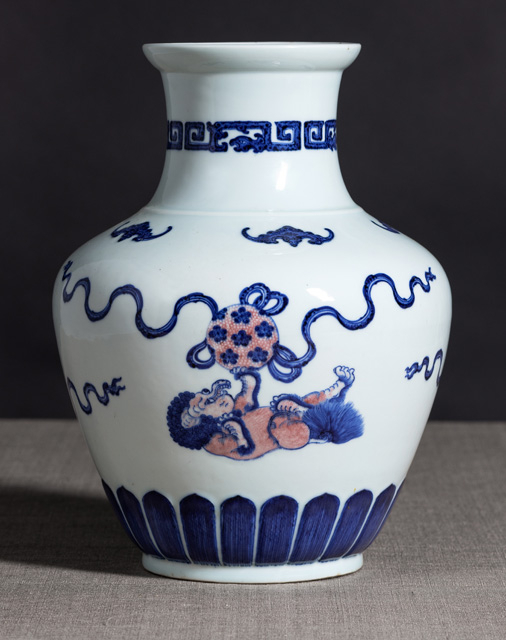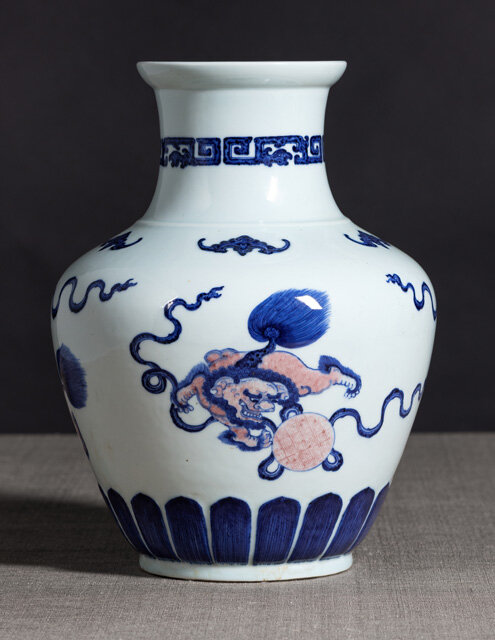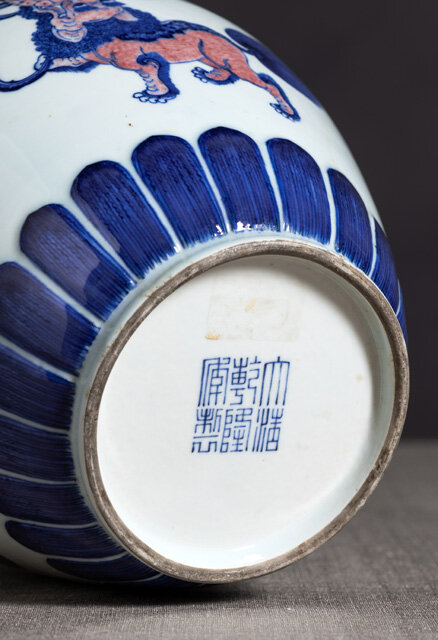A highly unusual blue and white 'Buddhist Lion' vase, underglaze blue Qianlong six-character seal mark and possibly of the perio
Lot 19. A highly unusual blue and white 'Buddhist Lion' vase, underglaze blue Qianlong six-character seal mark and possibly of the period (1736-1795). H. 32,9 cm. Estimate 40,000-60,000 €. Lot sold 620.000 €. © Nagel Auktionen
The body painted in underglaze-red and blue with three Buddhist lions, each detailed with large bulging eyes, flared nostrils, tightly coiled mane and a bushy tail, variously depicted playing with a beribboned brocade ball amidst flame wisps, one crouching with its head turned backward eyeing the ball, the other with its paw resting on the ball, and one lying on its back batting the ball into the air, all above a band of raised upright lotus petals, the shoulder moulded with five raised stylised bats just below a raised band, the waisted neck further encircled by a row of archaistic dragon scrolls rising to a trumpeted mouthrim, all supported on a short slightly splayed foot, the base inscribed in underglaze blue with a large six-character reign mark.
Note: The subject of Buddhist lions playing with beribboned balls dates back to blue and white porcelain of the early Ming dynasty, as portrayed on a jar attributed to the Yongle period, ill. in Regina Krahl, "Chinese Ceramics from the Meiyintang Collection", vol. 4, London, 2010, pl. 1643.
The design represents many auspicious associations symbolizing physical and spiritual power and conveys the wishes for high rank. This motif can be found in very similar execution on a garlic head vase of the Qianlong period, cf. Sotheby's HK, 8 Oct 2013, lot 3187. For a very similar vase in shape, lotus border, bats, and scroll decoration around the neck, cf. Sotheby's HK, 5 Oct 2011, lot 1924. Another comparison in terms of painting style and seal mark can be made with s smaller bottle vase, sold by Lempertz, Cologne, 15 June 2018, lot 101.
All these vases share a rare underglaze-blue Qianlong six-character seal mark, where the qian character includes an element on the left resembling the character you rather than the character ri as is usual. Geng Baochang in "Ming Qing ciqi jianding", Hong Kong, 1993, p. 344, describes this mark as an early mark used at Jingdezhen during the time of Tang Ying, Superintendent of the imperial kilns. Geng records the same mark on a box decorated in copper red and underglaze blue in the Palace Museum, Beijing, on a famille rose brushpot inscribed with a poem composed by Tang Ying, and on a blue and white brushpot inscribed with a poem in the Guandong. This association is also made by Peter Lam in "A Dating Framework for Qianlong Imperial Ware", Oriental Ceramic Society, London and Hong Kong, lecture given 15 Dec 2009 and 20 Jan 2010, where he dates the seal mark to before the 21st year of emperor Qianlong's reign (1756). F
urther examples of vases bearing related Qianlong reign marks include two lantern vases decorated in underglaze blue and red, one in the Wang Xing Lou collection, included in the exhibition Imperial Perfection. The Palace Porcelain of Three Chinese Emperors, Minneapolis Institute of Arts, Minneapolis, 2004, cat. no. 27; and another sold at Christie's London, 9th December 1985, lot 124.
Nagel. "Asiatische Kunst - Salzburg", 06.12.201

/https%3A%2F%2Fprofilepics.canalblog.com%2Fprofilepics%2F1%2F0%2F100183.jpg)
/https%3A%2F%2Fstorage.canalblog.com%2F03%2F02%2F119589%2F96711876_o.jpg)
/https%3A%2F%2Fstorage.canalblog.com%2F11%2F31%2F119589%2F94773502_o.jpg)
/https%3A%2F%2Fstorage.canalblog.com%2F20%2F83%2F119589%2F94772815_o.jpg)
/https%3A%2F%2Fstorage.canalblog.com%2F26%2F72%2F119589%2F75604929_o.jpg)
/https%3A%2F%2Fstorage.canalblog.com%2F59%2F60%2F119589%2F26458628_o.jpg)





/image%2F1371349%2F20240416%2Fob_2a8420_437713933-1652609748842371-16764302136.jpg)
/image%2F1371349%2F20240414%2Fob_83ee65_2024-nyr-22642-0954-000-a-blue-and-whi.jpg)
/image%2F1371349%2F20240414%2Fob_15808c_2024-nyr-22642-0953-000-a-blue-and-whi.jpg)
/image%2F1371349%2F20240414%2Fob_e54295_2024-nyr-22642-0952-000-a-rare-blue-an.jpg)